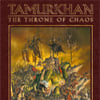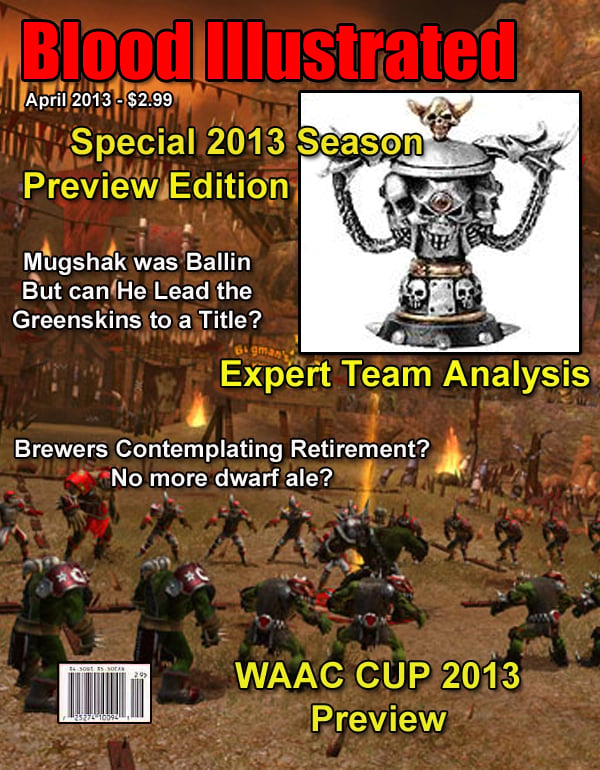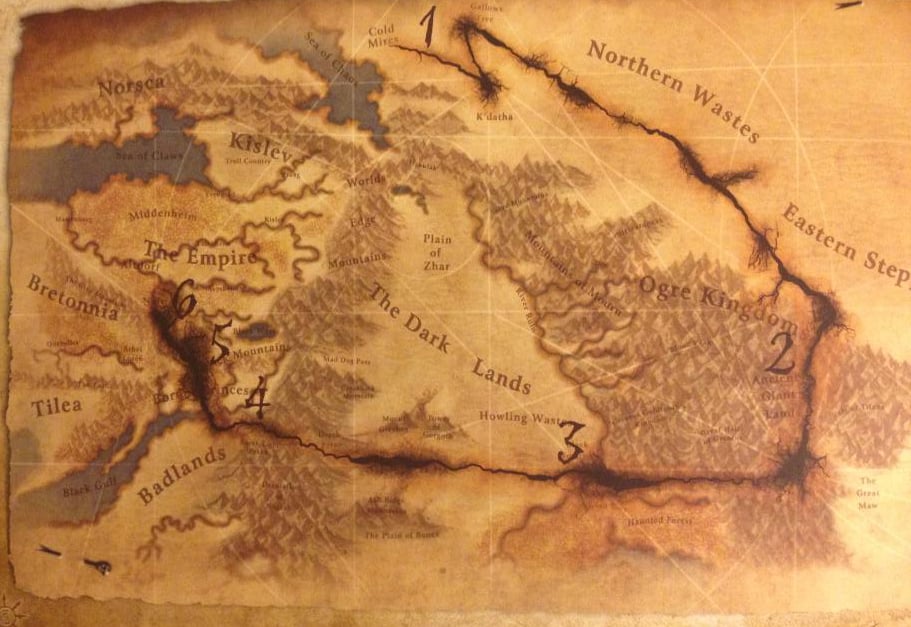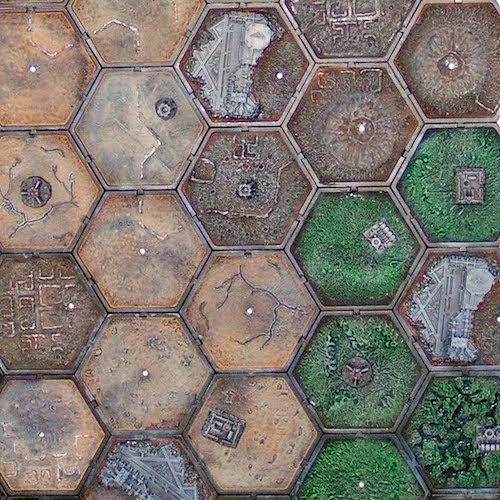Forging the Narrative – Part III – Narrative Campaigns
11 Minute Read
Jun 29 2014

Advertisement
Over the past two articles in this series, we have explored what Narrative Gaming is exactly, and what Campaign Gaming is about and some of the pitfalls that one can encounter while attempting to organize a campaign event.
We now come to the part of the series where we begin to discuss some of the various types of campaigns that we can get our hands on and play with our friends, as well as some of the pros and cons of those individually. We start with what is in my opinion the easiest of the campaign types to run to its conclusion: the Narrative Campaign.
A Narrative Campaign will follow a story arc from a beginning point to an end point. It can be as simple as three story points that are reached one battle after the other. It can be as complex as a dozen story points that represent a battle, each with branches that lead the players to points only accessible via a victory or defeat. It can utilize an experience system, or it can simply be about playing a set of games until you reach the conclusion and tally a score up. I have played in a narrative tournament that was five battles over the course of a Saturday and a Sunday, where we were put in one of two factions, and the game results would lend bonuses or penalties to our side depending on how we did as we followed an overall story plot that the event organizer had written.
Ultimately I feel that these make for the best campaigns to run if you have a more casual group, or if you are new at running campaigns, because there is really not a lot of book keeping at all unless you actively choose to implement systems of experience in. They only need the story that they will follow, all of the battle points fleshed out, and a schedule to play the games.
Where to Begin
The best place to begin I feel is to start off with an already published campaign. The only thing that you will have to do is to read the material and become familiar with it as well as go over any mechanics and scenarios that are present. This will also give you a framework that you can use in the future for your own creations and will plant the seeds for many adventures to come in the months and years forward.
There is quite a bit of campaign material already out there, and I would recommend picking up something from Forge World. If you are a fantasy player, the only real book that you have is the Tamurkhan – Throne of Chaos campaign. If you are a 40k player, there is a large source of data and material from you to pull from.
Using a pre published campaign lets you not worry so much about mechanics and lets you focus on story. However, that does not totally stop you from injecting your own pieces into the story either.
Tamurkhan – The Throne of Chaos (Warhammer Fantasy Campaign)
For example, in 2013 my campaign group ran Tamurkhan. I broke down the major battles into six distinct chapters, with each chapter lasting one month. We have a campaign day which sits on the last saturday of every month. One of the major battles from the book would be fought on each of those days. Additionally, we have a floating flex game where the players are scheduled a battle against an opponent that they can play anytime during the month at any location they and their opponent wish. These battles would all contribute points toward their faction, which I record and keep track of in a database which is pulled by http://www.louisvillewargaming.com to display the standings.
As the story went on, it was possible that the actions in the campaign could not mesh up with the story in the narrative, and that was fine! We just altered the storyline a little bit and it matched up to the Throne of Chaos campaign overall. Our final battle consisted of a massive twenty-five foot long table and there were over thirty players involved in our game store that is located in a shopping mall.
The battle was epic, with timed rounds and a constant flow of curious onlookers taking pictures. Tamurkhan was slain by an elven bolt thrower in the end, but his forces managed to sack Nuln and burn it to the ground! This result stays with us in our version of the Warhammer world and in future campaigns is a part of our ongoing narrative.
Imperial Armor Eight – Raid on Kastorel – Novem
Our 2014 40k campaign runs from January through June and follows the same basic format as the Tamurkhan campaign above (I rotate six months with 40k and six months with fantasy to keep interest sparked and prevent burn out). The 40k narrative has been running for over a decade through various campaign systems. The jist of the current narrative is that an ancient eldar prison artefact was discovered housing an ancient necrontyr warlord and this is the object of many campaigns (to capture or try to imprison).
Last year on the planet Rubicon (completely custom created system and world) the artefact was spirited away by the orks and so for 2014 the Imperial Armour Eight campaign was run – which depicts the Raven Guard and Elysium drop troops attacking an ork world.
Some modifications were made to the narrative to allow for a third faction (the xenos eldar, dark eldar, tau, and necrons).
Faction Based Warfare
 One of the most challenging aspects of developing a narrative or working with a narrative campaign is that you are going to inevitably have players that want to run armies that are not featured in the campaign.
One of the most challenging aspects of developing a narrative or working with a narrative campaign is that you are going to inevitably have players that want to run armies that are not featured in the campaign.Imperial Armour Eight, for example, features orks taking on Raven Guard and Elysium Imperial Guard. That leaves out pretty much everyone else, so some creative work was done to give other factions at least a passing reason for being here.
In addition, when you fight a campaign with only a pair of factions you run the risk of having one faction run away with the score in the beginning – which is an unfortunate catalyst in causing other players to quit the campaign because they don’t feel there is any way to win. As such, I enjoy having THREE or more factions involved, which helps balance out factions getting out of control and also gives you a vehicle to move players around to other factions should the need arise (players quitting for example leaving a faction underhanded).
Other Space Marine Chapters – aiding the Raven Guard. One of our players is using the Scorpions list from the Badab War (which ties in great for our next campaign which will be the Badab war) and is tying in Alpha Legion to his chapter. That is his background and he’s really pushing the narrative in a direction where you do not know if his chapter is really for the imperium, or fighting for other reasons (one never can tell with Alpha Legion)
Tau – The tau’s presence simply followed the guise that there was a power present that needed secured For the Greater Good
Eldar & Dark Eldar – The prison holding this warlord was placed in the webway long ago before mankind was even crawling out of its evolutionary oceans as fish. This represents a mistake or stain on their conscious that must be fixed. This gave rise to the character The Crimson Witch – a hate filled eldar spirit seer that was set afire and became the Burning Witch – vessel for the necrontyr warlord.
Necrons – this one was more obvious. The necrontyr warlord is sought by the necrons as either a powerful ally or as a criminal they want control over.
Thus these three were bound into one “faction” that had similar goals – remove the Prisoner from the ork factory-world and beat the imperium to it.
Players Joining and Quitting
Another benefit of factions is that one person does not control an entire faction. This means that players can freely join your campaign whenever, and players that quit will not cripple the campaign because the faction is still in existence and there are still players fighting battles for it. Anytime I work with any campaign system, this is one of the first things that I look at – the ability to circumvent campaigns crashing when a player quits, because as I discussed in the previous installment of this article series, quitting players are going to happen so you must be prepared to handle it when it does happen.
Tying it All Together
 Once all of your faction information is ready to go you simply need to find a system that works for your group and go for it. As I mentioned above, we have two games a month. One set campaign day and one flex day against a scheduled opponent.
Once all of your faction information is ready to go you simply need to find a system that works for your group and go for it. As I mentioned above, we have two games a month. One set campaign day and one flex day against a scheduled opponent.Each battle is worth a set of points which I keep track of in a database tied to a website, but you could easily use a spreadsheet or just post it to something like Facebook if you wanted to. At the end of each chapter the winning faction gets a bonus for the last battle.
The final battle is where most or all of the campaign bonuses get applied to. A final big time explosive battle to determine who is going to take the campaign and who is going to go home until next season. This setup works the best in my opinion because a faction can get really unlucky through most of the campaign but still have a chance to pull things out at the end and win overall.
This very thing happened in our Rubicon campaign that we ran in 2013. The imperials lost every chapter, but pulled off a striking last battle win despite having their backs to the wall. Had they not had a chance to win the campaign up at that point, there would not have been a final battle.
The key is that there is a set structure for a beginning and an end. An end battle should be something everyone looks forward to.
Additional Mechanics
The complexity of your campaigns will ultimately depend on you and your group. The information above is really all you need to launch a narrative campaign. However, nothing is stopping you from incorporating additional mechanics to the campaign or house rules to further customize the set of games into fitting what the narrative needs. Some examples of this may include:
- An experience system where units and characters can gain additional abilities (Tamurkhan features one of these for example)
- Ally mechanics (either new mechanics or in addition to existing)
- Modified building rules
- Using other games for your battles. For example, in 40k you could use Battle Fleet Gothic games as well to represent ship battles
- Using expansions such as Planet Strike, City Fight, Zone Mortalis, Kill Teams, and Apocalypse in your battles. 40k does not have to be the only way you resolve battles!
- Having a Game Master present for big battles. For example – our final game will feature a 1000 point zone mortalis game into the depths of an ork factory where the top players from each of the three factions will be fighting to recover the Prisoner’s vault. There will be encounters that get rolled and the environment is as much of an enemy as the other forces are – and the Game Master will be running those neutral forces that are trying to stop the players just as they would in an RPG.
Creating Your Own
Using an existing campaign may be an option, but what you may want to do is to write your own. The problem is where do you start?
The first thing that I come up with is the overall story arc. Lets say that you have five players in your group: two space marine players, an imperial guard player, a chaos player, and an eldar player. I find that there is usually no shortage of imperial players so I always figure that the imperium is going to be a steady imperial presence.
So based on that hypothetical situation, I would divide the players up into two factions. The imperium, and the opposition.
Next – why would chaos and eldar team up? It would have to be something dire indeed. We can always look to video games for inspiration. Dawn of War and Dawn of War II both had chaos and eldar fighting our Imperium protagonists. Perhaps a chaos warlord has unearthed something that the inquistion wants and the eldar know that if the imperium gets their hands on it that they will use it to eradicate one of their worlds. Very basic, you can flesh it out more, but that gives you a starting point. You have chaos and eldar not really on the same side but fighting for a common cause though diametrically opposed view points.
So we have the basics, lets look at hooking these up into a campaign of some sort now. Lets give it three chapters or three battles. This is fairly easy to get through, basic enough to write for, and will give your group a sense of accomplishment at having started and completed one.
The initial contact between the imperium happens in a ruined city. The item that the chaos warlord found was in a dank basement of an old ruined building. Therefore, we will use City Fight for our first battle. You could come up with your own scenario (this is a lot of fun I find) or just roll randomly in the City Fight book.
Assign a victory condition now. What does this battle represent? Lets say that the chaos warlord’s force is trying to send a beacon to their craft in orbit for extraction and the Imperium must prevent this. If the chaos warlord accomplishes this task, he receives reinforcements in the final battle. Lets say +250 points. If the imperium wins then they have succeeded in cutting off their enemies’ communications and in the final battle they will always be able to choose who deploys first and who goes first as they have their enemy cut off and reacting to them.
Again very basic, you can flesh it out or use a different condition if you want. I like to have varying conditions, not just say both sides get +250 points if either wins. That is just my preference though.
Battle two could be a normal battle rolled out of the rulebook at 1500 points. The two forces clash on a hill near the ruined city.
Battle three can be split into two battles. One battle could be an Escalation type battle with a Lord of War and the other battle could take place inside of a building using Zone Mortalis rules and apply the victory conditions from Battle One and Two to these battles.
The overall victor of Battle Three wins the campaign and everyone can go out for a beer (or a soda if one is not old enough to drink of course) and discuss plans for the next campaign.
Concluding
Narrative Campaigns are the easiest of the campaign types to run and there is a lot of resources out on the internet as well as published by Forge World and Games Workshop to help you.
Games Workshop as of late has been publishing Apocalypse War Zones which are good for some ideas and Forge World has an entire library of campaigns that you can pull from. The older ones may need to be modified a little bit to bring it up to speed with the current edition of the game, but the story remains the same.

I would strongly recommend Tamurkhan to any fantasy players, and the Badab war (Imperial Armors 9 and 10) are classics as well to look for in the narrative world. These will give you great experiences, and will help seed your imagination for your own narrative in the months and years to follow.
Auticus currently resides in Louisville and helps organize narrative events there among the various game stores. He has been playing gaming since the late 80s from historical tabletop to Battletech to GW games like Warhammer and 40k. You can find onine here www.louisvillewargaming.com
Tell us about your campaign gaming experiences.
Author: Larry Vela
Advertisement






